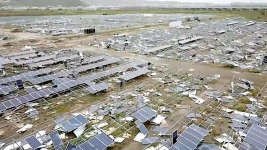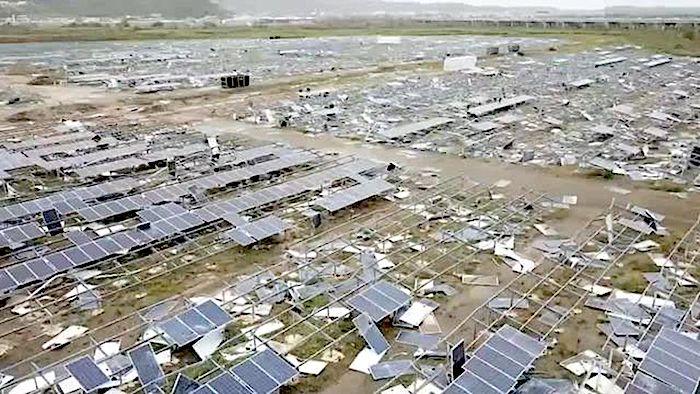How war in Ukraine sank Europe’s net zero plans
European politicians are reconsidering climate change action as they fear being punished by voters facing surging food and energy prices
ByJames Crisp, EUROPE EDITOR26 September 2023 • 11:26am
Rishi Sunak is not the only European leader watering down his net zero ambitions in the face of a cost of living crisis caused by the war in Ukraine.
Putin’s illegal invasion sharply reduced economic growth and “considerably” pushed up inflation across the Continent, the Swiss National Bank said on Friday before warning worse was to come.
The British prime minister delayed a ban on petrol engines by five years to 2035, slowing the switch to expensive electric cars, and gave homeowners
more time to swap their fossil fuel boilers for initially costly heat pumps last week.
EU countries have less freedom to
chop and change green rules because the bloc has agreed a binding 2035 internal combustion engine ban, as well as emissions reductions targets of at least 55 per cent by 2030 and 100 per cent by 2050.
Politicians fear being punished by voters who are feeling the pinch of surging food and energy prices.
UK government said it would issue hundreds of new oil and gas licences in the North Sea to secure energy reserves while still aiming for net zero CREDIT: ANDY BUCHANAN/AFP
“There is certainly a trend of
some European politicians backtracking on climate action,” said Mats Engström, Senior Fellow at the European Council on Foreign Relations think tank.
“Energy prices have been high and recent decisions on climate targets now have to be implemented in difficult sectors such as housing and transport,” said Mr Engström.
“We are fully aware of
calls for a slowing down of the green agenda and demands to avoid additional burdens on citizens and businesses,” Katja Rosenbohm, the head of communications at the EU’s European Environment Agency, told the Telegraph from Copenhagen.
“The war in Ukraine and the cost of living and energy crises brought new pressing challenges to the top of the political agenda, but we cannot talk about these challenges without talking about the existential threats posed by climate change, biodiversity loss and ecosystem collapse.”
Silvia Pastorelli, Greenpeace EU climate campaigner said, “We’re seeing a pattern of dishonesty from politicians across the EU and UK about who benefits from rolling back climate solutions and who pays the costs.
“The real winners from keeping our homes draughty and cars burning oil are the fossil fuel giants already making billions from this crisis.”
But
the war in Ukraine has also accelerated the transition to renewable energy from Russian gas in Europe, as the continent moved to wean itself off Kremlin-controlled fossil fuels after the invasion.
“There’s rhetoric and then there’s reality,” said Peter Chalkley, director of the Energy and Climate Intelligence Unit.
“The pace towards net zero in Europe has sped up in the past couple of years due to pure economics, with renewables now cheaper, and energy security concerns sparked by Russian gas dependence helping to push sales of electric heat pumps through the roof.”
He added,
“Coal is below pre-Covid levels and that combined with wind and solar generating more electricity than gas for the first time last year means emissions are falling.”
Even so,
politicians across Europe are reconsidering their net zero plans in a way that seemed unthinkable before the unprovoked Russian attack on Ukraine.
France
Emmanuel Macron was president of France during the UN summit which led to the Paris climate change agreement in 2015.
Ever since, he has worn his green credentials on his sleeve as a point of pride.
But even Mr Macron is not immune to the backlash against green regulations since the war in Ukraine.
French activists holding inverted portraits of Emmanuel Macron during a climate change protest in front of the Eiffel Tower CREDIT: BENOIT TESSIER/REUTERS
On Sunday, he announced that
France would not be banning gas boilers in homes because it would be unfair on people in rural areas.
He said the French “love their car, and I do too,” and
announced a subsidy scheme to lease European-made electric cars for about 100 euros per month
However, his
failure to give a date for phasing out fossil fuels, with the exception of coal, was branded “underwhelming” by environmental groups.
Germany
Berlin passed
a watered down oil and gas “boiler ban” after months of outcry over the cost of new greener heating systems.
Germany’s best-selling newspaper Bild had campaigned against what it branded “the heating hammer”.
The law sparked bitter infighting among Olaf Scholz’s SPD-led ruling coalition and coincided with a record rise in support for the hard-Right AFD party.
The legislation was so heavily amended that
the bill will now only cut about three quarters of the polluting emissions it had targeted as part of Berlin’s push for net zero by 2045.
European Union
The EU’s Green Deal is a package of laws agreed in 2020 that aims to make Europe carbon neutral by 2050. But its policies have come under increasingly ferocious attack before European Parliament elections next year.
In a crucial July vote, the European Parliament defeated an attempt by the centre-Right European People’s Party (EPP) to veto a law to rewild a fifth of the EU’s land and sea habitats from 2030 .
The EPP has called for a pause on environmental legislation to prioritise economic growth and jobs, despite the Green Deal being a flagship policy for EU members and Ursula von der Leyen, the European Commission president.
The party has demanded Europe’s farmers be spared burdensome red tape and called for strict protections for resurgent wolves to be relaxed, which Brussels has said it will consider.
“We are not changing in any way the ambitions at the heart of the Green Deal, or the targets that have been set,” a European Commission spokesman told the Telegraph.
Pieter de Pous, of climate change think tank E3G, said there was “an emerging trend across Europe” of politicians jumping at the “first opportunity to roll back” green measures they never really wanted to adopt in the first place.
He said they targeted areas that “easily lend themselves for outrage like farming, cars or housing” and often in “tacit cooperation with an emboldened far-Right”.
A worker checks metal label on a valve at the Dashava natural gas facility in Ukraine, a transit station along the natural gas pipelines linking to western Europe CREDIT: Sean Gallup/Getty Images
Earlier this month, Roberta Metsola, the European Parliament’s president, warned climate regulations were fuelling support for populist politicians ahead of the elections.
She called for a “proportionality test” and cost assessment of climate regulations before an election where climate change and green regulation is already a battleground.
Meanwhile, a number of European Union member states are pushing for new emission rules to be eased before the bloc’s ban on the sale of petrol and diesel cars enters into force.
France, Italy and the Czech Republic are among a group of EU nations calling for the new emissions limits to be weakened.
Spain, which holds the EU’s rotating presidency, proposed a delay to the so-called “Euro 7” rules, which place an upper limit on CO₂ emission levels for new cars sold in Europe.
Under Madrid’s compromise, carmakers would be given an extra 24 months to comply, while 48 months would be given to manufacturers of buses and trucks over 3.5 tonnes.
The fudge agreed on Monday among EU governments, however, does not weaken the rules.
“Despite some of its members being poorer than the UK, the EU is not backing down on its phase-out of combustion engines,” said Julia Poliscanova, senior director for vehicles at Transport & Environment, which campaigns for zero emission mobility.
Italy
Giorgia Meloni’s Right-wing government claims
local businesses cannot afford to reach the EU green targets.
Rome has called on the EU to
water down rules to improve the energy efficiency of buildings, arguing that it “risks damaging Italy” and needed
a “gradual approach” rather than a decade-long target.
Italy has also
pressed the EU to change its plans to phase out petrol and diesel engines.
Giorgia Meloni has denied the government, which was voted in last year, was made up of ‘dangerous climate change deniers’ CREDIT: GUGLIELMO MANGIAPANE/REUTERS
In March, Ms Meloni denied the government, which was voted in last year, was made up of “dangerous climate change deniers”.
“We believe that, in respecting the international commitments made on the reduction of climate-changing emissions, a pragmatic approach should be taken, not an ideological one,” she said.
“Environmental sustainability must not be separated from economic and social sustainability.”
Sweden
Sweden, the homeland of Greta Thunberg, the climate activist, has admitted it
will miss its 2030 emission reduction targets after cutting tax on polluting petrol and diesel.
It will also
cut funding for climate measures next year by £19 million. The government also plans to
abolish a tax on plastic bags designed to reduce waste.
A worker in a power plant repairs damage after a Russian attack in central Ukraine CREDIT: Evgeniy Maloletka/AP
The minority-run coalition is propped up by the hard-Right
Sweden Democrats, which has been described as
the most anti-Green Deal party in the EU.
On Friday, demonstrators took to the streets of Stockholm after the movement started by Ms Thunberg,
described the new government budget as a “big betrayal”.
Poland
Poland has filed l
egal challenges against three of the EU’s main climate change policies, including
the law to ban the sale of new petrol engine cars from 2035.
Warsaw argues that the laws represent
an “excessive burden” on poorer people, a
threat to energy security and that they put
coal mining jobs at risk.
Poland has, until a very recent spat over grain imports, been one of Kyiv’s staunchest supporters and welcomed more than 1.6 million Ukrainian refugees, despite its economy slowing because of the war.
Netherlands
Dutch government
plans to meet EU nitrogen emissions reduction targets
with compulsory farm buyouts led to
a drubbing in regional elections earlier this year.
Caroline Van Der Plas of BoerBurgerBeweging (BBB), the Farmers-Citizen Movement CREDIT: BSR Agency/Getty Images
The Farmers-Citizen Movement (BBB) came from nowhere to become the largest party in all 12 Dutch provinces in a vote dominated by tractor protests against green laws.
Since then,
the coalition government collapsed which means a general election in November that could prove crucial for the future of green laws in the country.
The election will be fought by, among others, the BBB, and Frans Timmermans, the former EU climate chief who left Brussels to contest the vote.







